DISCLAIMER: The vast majority of this information is either directly quoted from the sources below or only slightly changed. Very little of it is my original thoughts, save a paragraph here or there. I attribute the following completely to my sources and make no claims otherwise. If so desired I will remove this content from the website without hesitation if asked to do so by TIMEGHOST or by any of the original copyright holders. My intent is purely the sharing of historical knowledge regarding Canada and the Battle of the Atlantic.
Sources:
“The Far Distant Ships” by Joseph Schull, ISBN-10 0773721606 (An official operational account published in 1950, somewhat sensationalist)
“North Atlantic Run” by Marc Milner, ISBN-10 0802025447 (Written in an attempt to give a more strategic view of Canada’s contribution than Joseph Schull’s work, published 1985)
“Reader’s Digest: The Canadians at War: Volumes 1 & 2” ISBN-10 0888501617 (A compilation of articles ranging from personal stories to overviews of Canadian involvement in a particular campaign. Contains excerpts from a number of more obscure Canadian books written after the war, published 1969)
The End of 1940, Rise of the U-boat threat, the Corvette waddles into the War, Expansion Headaches at Every Turn
The end of 1940 was a peculiar time for escort operations, and pre-war concepts of trade defence and ASW were by this point under serious strain. Losses were climbing, and authorities were searching for effective countermeasures. There was a strong lobby within the RN, supported by Churchill whilst he was First Lord of the Admiralty and after he became prime minister that favoured offensive action against U-boats by even the slenderest of escorts. The two schools of thought, one favouring an active pursuit of the enemy and the other the primacy of escort, were still matters for debate when the Canadian destroyers joined the Clyde Escort Force. Through the winter the issue was resolved in favour of defence as the first priority. However, in light of the subsequent Canadian tendency to pursue even the most tenuous contacts with zeal, it is questionable if this resolution really resolved anything.
By January 1941 all the River-class ships and four of the Towns were operating from the Clyde. During this second winter of the war there were also Canadian corvettes in the Clyde Escort Force participating in the crucial battles of the first phase of U-boat pack attacks. These corvettes were actually the ten of their class built in Canada for the British. All were completed before the freeze-up of late 1940, and the RCN assumed responsibility for their acceptance from the builders, commissioning into the RN, and manning for passage to the UK. Unfortunately the handover would not proceed as planned, and Canada would end up taking all ten into her own service.
This story of the “British” corvettes and their transfer to the RCN is an important one, for it illustrates the kinds of problems the RCN had when dealing with the RN. Because the ships were manned for passage only, their crews were the barest minimum, roughly assembled from spare hands, all of whom were designated for other duties upon completion of the crossing. For example, personnel from the first corvettes to go across were assigned to HMCS Dominion, the RCN’s depot in Britain. They were to form a manning pool for the destroyers already on operations in British waters. Those from the later passages were to return immediately to commission new RCN corvettes. All ten “British corvettes” had crossed over by early 1941, but from the outset it proved impossible to obtain the release of their crews. As early as October of 1940, Dominion Depot had requested, on behalf of the Admiralty, that the crews recently arrived on the corvettes after passage be allowed to remain onboard until the end of November. Reliefs for destroyer personnel, it was explained, could be drawn from the smaller ships and the ships turned over to the RN in piecemeal fashion.
NSHQ concurred, but no British replacement crews were forthcoming, and the issue remained unresolved. The corvettes and their “passage-only” crews began escort operations with the Clyde force. By February 1941 the delay in the release of men from the British corvettes began to affect planning of the RCN’s own expansion. Commodore G.C. Jones, RCN, commanding officer, Atlantic Coast (COAC) complained that the men should be returned to Canada before the opening of the St Lawrence River deluged the navy with new ships. He was told by NSHQ that the matter was ‘under review and a decision was pending’. In April 1941 the Admiralty again requested that the crews be allowed to remain so as to not decrease the efficiency of their own efforts. As the ships were now operational, this was a fair concern, however the fact that the Admiralty was desperate enough to beg for poorly-provisioned ships with passage-only skeleton crews to not be taken away says much about the worsening situation at sea. It also suggests that communications between the RN and RCN were not what they should have been. This misunderstanding over the nature of the RCN’s commitment to the ten British corvettes was to have lasting repercussions, but for the moment, the Admiralty’s concern for efficiency of escorts operating in the embattled Western Approaches took precedence over all else. The RCN acquiesced, so long as the ten corvettes were commissioned HMC ships. The Admiralty accepted this and undertook the costs and arrangements for refits, maintenance, and alterations and additions to equipment. The RCN was to look after running costs, pay, victuals, and the like. (A similar arrangement existed with other Allied navies that undertook to man British warships fully themselves.)
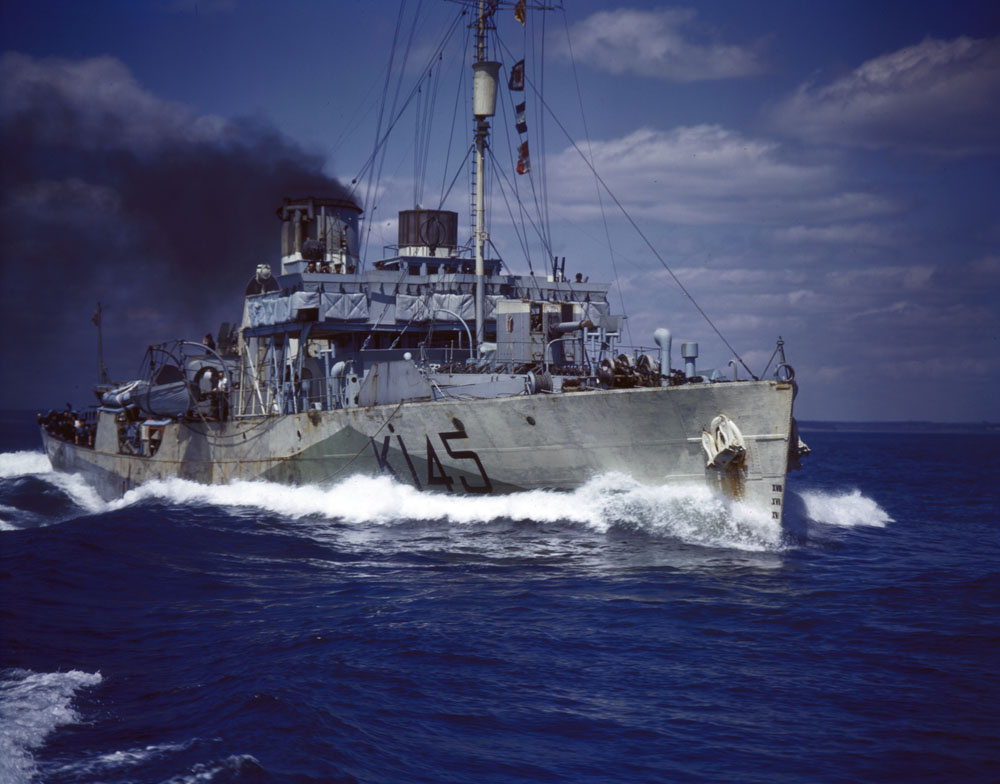
(HMCS Arrowhead, one of the ten "British" corvettes built in Canada. Photo taken much later in the war 1944-45)
Speaking of the Corvettes themselves, the little vessels were 190 feet in length, 33 in beam, with a speed of sixteen knots and a planned armament of one four-inch deck gun,a stock of depth charges, and a lone QF 2-Pounder Pom-Pom gun mounted on the ‘bandstand’ above the engine room.With a planned crew of 80-90 men. Out of necessity, their armament would grow and change over the years. Many of the original RCN corvettes would also be fitted with minesweeping gear. Shortages meant that many would forego their planned armament of a single 2-Pounder Pom-Pom, instead receiving two Lewis guns ( what these were supposed to do in the event of modern air attack was unknown.) Thankfully, most of them would never get within range of Luftwaffe bombers. The few of their own corvettes that the RN assigned to the Mediterranean all received significant Anti-Air armament. The use of triple-expansion machinery instead of steam turbine meant the largely reserve/ex-merchant crewmen had an easier time working below. Underwater detection capability was provided by a fixed asdic dome; later modified to be retractable. Subsequent technological developments; like the High Frequency Radio Detection Finder or ‘Huff-Duff’ would be added along with a number of different Radar systems. More men would be added to crew these systems, putting demand on a ship where space was already at a premium.
They could be serviced by practically any small dockyard or naval station so many ships came to have a variety of different weapons systems and design modifications depending upon when and where they were refitted; there was really no such thing as a ‘standard Flower-class corvette’. Several of the major changes are listed below.
- Original twin mast configuration changed to a single mast in front of the bridge, then moved behind the bridge for improved visibility
- Heavy minesweeping gear removed to improve range
- Galley relocated from stern to amidships
- Extra depth charge stowage racks added to the stern. Later more storage was added along the walkways
- Hedgehog weapons system fitted
- Surface radar fitted on 'lantern" housing on the bridge
- Forecastle lengthened to midships to provide more accommodation and better seaworthiness. Several vessels received a “3/4 length extension”.
- Increased flare at the bow. This and the forecastle lengthening would become standard features on new ships.
- Various changes to the bridge, typically lowering and lengthening it. Enclosed compass house removed.
- Extra Lewis guns mounted on the bridge or engine room roof.
- Oerlikon 20-mm cannons fitted, usually two on the bridge wings, but some times as many as six spread out across the ship. Depended greatly on theatre of operations.
Any particular ship could have could have any mix of these, as well as other specialist one-off modifications.
A major difference between the RN vessels and the RCN, later USN, and other navies’ vessels was the provision of upgraded asdic and radar. The RN was a world leader in developing these technologies, and thus RN corvettes were somewhat better-equipped for remote detection of enemy submarines. A good example of this is the difficulty that RCN corvettes would have in intercepting U-boats with their Canadian-designed SW1C metric radar, while the RN vessels were equipped with the technologically advanced Type 271 centimetric sets. In addition, RCN vessels were incapable of operating gyrocompasses making asdic attacks more difficult.
The corvettes would never be handsome or comfortable ships. They would, as some cracked, "roll even on wet grass." The captains who took them over were mostly ex-merchant officers, and whilst it was an unpleasant command, many developed a grudging respect for them. On the slipways of the Canadian coasts and the Great Lakes, the rest of the corvette fleet was continuing on schedule.

( A British corvette, HMS Picotee. Picture taken either before the war or before modification as a number of original design features can be seen in this picture including a much shorter bow and forecastle and a mast in front of the bridge, although the second mast has been removed.)
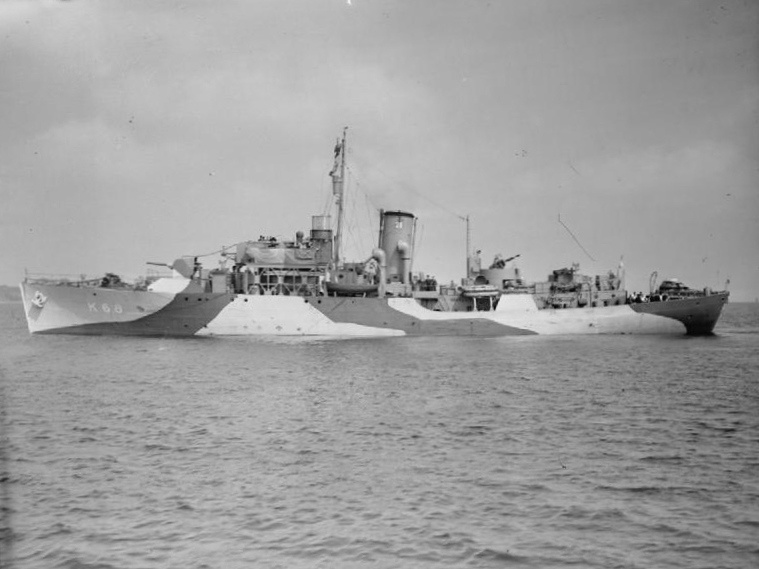
(Later in the war, HMS Jonquil, showing the changes to the bow and forecastle)
Terrence Robertson described for Maclean’s the first time he saw a RCN corvette at sea:
"She was Canadian-built, Canadian-manned and named "Windflower" (incidentally one of the ten built for British use, then "returned" to the RCN). When the destroyer on which I was serving met this newcomer to the Atlantic battlefield in January 1941, we not unnaturally approached for a closer look. We saw on her foredeck a four-inch gun with a wooden barrel that drooped. Then we were warned to keep clear of her stern with the immortal signal: "If you touch me there I’ll scream."

(HMCS Mayflower, one of the first ten corvettes built in Canada like her sister Windflower. Photo from 1942)
The ten British corvettes were the second group of ships forced upon a reluctant RCN by the British in less than a year. By RN standards the attendant manpower requirements for the ten corvettes and six Town destroyers was not very large (about 1200 men all ranks), but their acquisition represented a unexpected major expansion for the RCN. The means whereby the corvettes came into Canadian service also illustrates what was for the RCN a recurrent problem, that of obtaining the release of both men and ships lent to the RN. The first incident may well have been an absent-minded assumption on the part of many British officers that the RCN was committed to some form of Commonwealth navy.
In any event, the RCN at least put up a good fight, better than any of its later attempts, but once committed to the common cause, it had little choice but to turn in the direction where the powers that be deemed its efforts would achieve the most good. More seriously, the actions of the Admiralty seemed to insist that the Canadian navy could accept a delay in developing its own efficiency in its corvette fleet. The ironic part came a few weeks later when the Admiralty urgently requested that RCN corvettes be committed to convoy operations in the Northwest Atlantic. If Canada’s naval expansion seemed to lack direction, it is small wonder.
Provision of officers and men for the navy’s new ships was of course a primary concern as 1940 drew to a close. Much of the RCN’s disposable manpower went into the Four-stackers and corvettes. With most of the experienced personnel fighting across the ocean, the navy had no access to people who could train new recruits or to berths on operational warships to train new officers and key non-substantive ratings. With proper management, a modest interchange of new drafts and experienced personnel would have permitted a more orderly expansion of the fleet and shore establishments and would have softened the devastating impact of expansion in 1941. The navy considered this problem, and the Staff discussed the possibility of routing the occasional destroyer to a Canadian port where personnel could be exchanged. But the Naval Staff concluded that ‘it would be a most unwise policy to interfere with any large percentage of a ship’s company when that vessel was acting in a War Zone.’
The first RCN corvettes to become operational therefore were commissioned with scratch crews. Although the navy kept its sound policy of not tampering with escorts in a war zone, the conditions which persisted over the winter of 1940-41 changed by the following spring. By then the fleet was operating closer to home and, technically at least, no longer in a war zone. In late 1940 the RCN was faced with building up manpower needed to commission fifty-four corvettes, twenty-five minesweepers, and small number of motor launches, about 7000 men all ranks.
Windflower and Mayflower were the first two Canadian built corvettes to make the passage to England. The navy was short of suitable weapons, so both had been fitted with dummy guns. The irrepressible pair were the first two of an eventual one hundred and twenty-two corvettes which, in the next four years, would carry thousands of pre-war farmers, miners, students, and white-collar workers into battle against the U-boat fleet. Their exploits were rarely spectacular, almost never heroic. But in the Battle of the Atlantic, the words "Canadian" and "corvette" became almost synonymous and the little ships created legends of courage and endurance.
They were needed more and more with each passing month. During the last week of February 1941, 150,000 tons of Allied merchant shipping was sunk; in the first two weeks of March 245,000 tons; and this rate of loss continued into April and May. Three or four ships and their cargoes were being sunk daily.

(Explosion of depth charges astern of HMCS Hamilton, August 30th, 1941.)
It was also becoming increasingly necessary to find men to man shore-based establishments, indeed it began to take precedence over the needs of the fleet. Although the navy was committed to its primary objective of increasing escort numbers and efficiency, the gradual extension of the war underlined the paramount need for bases. “The primary objective from the Naval point of view,” a Canadian Chiefs of Staff ‘appreciation’ of May 1941 observed, “must therefore be the extension of existing facilities and the provisions of new ones to meet the ever-increasing demands of the British - and perhaps the United States - Naval forces.” The expansion fleet was therefore only one part of a much larger plan of support for North Atlantic naval operations. Moreover, actual planning for the commissioning and work-up of the new escorts took place as the fleet assumed new and more demanding tasks. The concern of the Chiefs of Staff for facilities underlined the fact that even by the second winter of the war the navy’s growth was still held in check by enormous shortages. The situation was not going to get better anytime soon. In a meeting in autumn 1940, the Director of Naval Personnel estimated that the navy needed at least 300 RCNVR executive officers if they were to meet expansion requirements for next May when the next phase of construction was to begin. This was no easy feat, as the navy lacked proper training facilities needed to prepare so many officers. When plans were put forward of proceeding with building them, the final twist occurred. The navy had to first acquire the necessary land.
As Nelles explained to Admiral Sir Dudley Pound in a personal letter, the RCN was indeed making bricks without straw. The primary need was now quantity in all aspects of naval endeavour. Manpower, ships, and bases. With existing training establishments choked and new ones needing land first, the provision of personnel became more and more difficult and no less important. Urgency was doubled in the last month of 1940 when it became clear that Britain was involved in what Nelles described as "a Naval crisis equal to or greater than that which existed in 1917."
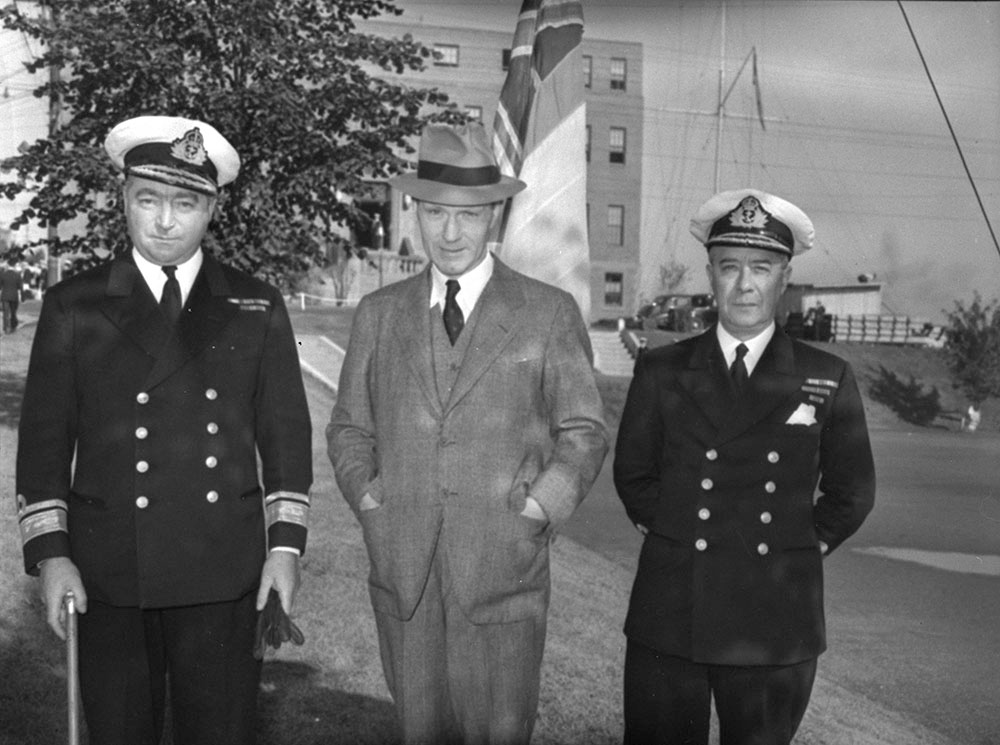
(Open image in new tab to see full picture. From left to right, Commodore H.E. Reid, Hon. Angus L. Macdonald, Minister of Defence for Naval Services, and Rear Admiral P.W. Nelles, September 1940.)
A deal was hashed out by which RCNVR officers-in-training would travel to England and learn at HMS King Alfred, the reservist training centre at Hove. The great irony of the scheme was that it once again proved virtually impossible to draw on this body of highly-trained personnel later on when the RCN was in desperate need of officers. Another aspect of proper planning was suitable work-up and training in actual ASW. Especially considering numerous British complaints of the low quality of Canadian ASW efforts on destroyers operating from UK bases. Canada had possessed no submarines since 1922 and had long since lost the ability to operate them. There was one submarine operating with the aforementioned Third Battle Squadron based in Halifax, the Dutch O-15. The RCN formally requested that she be made available for ASW training at the end of November 1940 but they were refused by the Admiralty. Some exercises with O-15 would happen late in the year.
Unable to obtain any aid from the British, the RCN turned to the US instead. Preliminary investigations were made into acquiring a older USN submarine in early 1941. Commodore H.E. Reid, the naval attaché to Washington, raised the matter with the new Permanent Joint US-Canadian Board of Defense and then set about beating the bushes in more obscure parts of the American capital. By the end of January it was clear there were no submarines to be had. The USN did make a gesture of assistance in the promise to send a squadron of submarines (four boats) on a courtesy visit sometime in the summer. The RCN was advised to prepare itself to make maximum use of two to three weeks of free asdic training time. It was a generous offer, but it did not provide the RCN with a long-term solution to the pressing problem of providing asdic trainees with proper targets. The offer was politely declined for this reason and for fear that acceptance would prejudice negotiations still underway regarding the future of O-15. A few days later the Admiralty signalled its consent to the use of O-15 for ASW training.
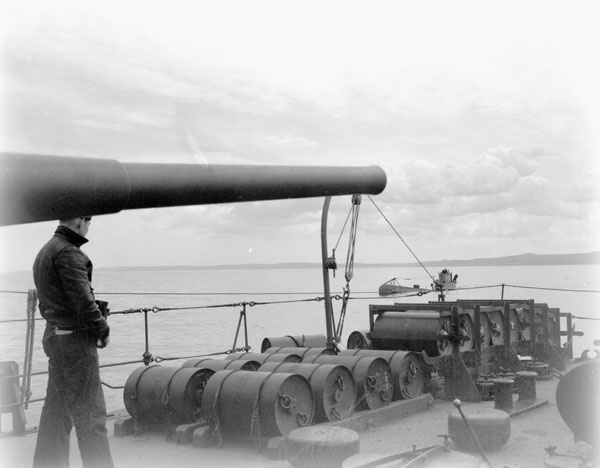
(View from the St. Laurent of Dutch submarine O-15 during an ASW exercise off Nova Scotia in August 1941)
While extremely useful, one submarine was simply not enough and the shortage would remain until 1943 when an infusion of Italian and Free French submarines would be directed into the Western Atlantic, in response to the need to train American-built British destroyer escorts commissioning from US ports. Having secured the services of O-15, there was no reason not to return to the Americans and their offer of training time on US subs. That the RCN saw fit to reject the offer in the first place was the first sign of a curious, closely-guarded attitude on the part of the RCN towards the USN. Nor were training submarines the only answer to preparing escorts for battle with the U-boats. Had the RCN and RN been paying better attention to what was actually happening at sea and seeing the wolf pack for what it really was ( a force of submersible torpedo boats) using groups of small craft and PT boats to simulate night attacks on the surface would have been adopted much sooner, but it was not until 1942 that the RCN would begin to use motor launches for that purpose.
Aside from the escorts operating from the UK, RCN expansion hung fire during the winter of 1940-41. Obviously it would have been better to commission twenty corvettes into the RCN during 1940, as the Staff had originally planned. But when winter closed its icy grip on the St Lawrence River, only four were operational on the east coast. A few more were patrolling and training in Pacific waters, and they would be joined by fresh ships commissioned on the west coast from British Columbian yards over the winter (6 ships all told). The last week of April brought the thaw, and with spring came the expected deluge of new ships. Orillia, Pictou, and Rimouski were down the river before the month ended. In May ten more were accepted into service, three more for the west, six more for the east. (Including HMCS Baddeck, the ship that Captain Alan Easton, who’s firsthand accounts I find quite fascinating, first commanded)
In addition to the ten Admiralty corvettes commissioned into the RCN. In a period of seven months thirty-three warships were added to the Navy List, slightly over half of the 1939-40 construction program. If it had been possible to build ships purely on the east and west coasts then the navy would have gladly done so. Unfortunately, heavy demand for repair work in east coast yards after the fall of France made it so that only three corvettes were ever built in the Atlantic Provinces, all at Saint John Shipbuilding. All three were much delayed, with the last, HMCS Moncton not taken into service until 1942.
Captain Easton would describe his first look at and first voyage of the Baddeck in 50 North: Canada’s Atlantic Battleground.
"… She was resting on the blocks of a dry-dock in a St. Lawrence River shipyard. I stood on the wall and looked down at this sturdy vessel which was to take me many miles over the ocean. HMCS Baddeck was mine; we were to spend a part of our lives together.
I was elated at being given command. When anyone is put in charge of something they feel important, they feel as though they have been singled out as above the crowd. But in my case the authorities probably had no alternative. There was no one else handy. In the navy during the first half of the war, there were not nearly enough people to go around. Often you got the job whether you deserved it or not.
I could see that the ship had been built after the fashion of a big steam trawler, but with a longer and sharper bow. In her nakedness, her fat belly seemed to bulge over the floor of the dry dock, suggesting an ample capacity for, among other things, a large engine. Her rounded stern was inclined to turn up like a duck’s tail.
The first sight of a ship in which one is going to sail is always exciting, that first glimpse which creates an immediate impression - perhaps of size or strength or just lowliness, sometimes curiosity, sometimes disappointment. I was not disappointed. It was Sunday and everything was quite, no hammering or riveting or steam from the machine shops. This was my private introduction. What was her character I wondered? Was her spirit yet born? Would she stay young like this or grow old quickly?
It was a month before I had an opportunity to try her on the broad St. Lawrence below Quebec. She had been fitted out by then, her crew had come aboard and she had been duly commissioned. Some of the men felt strange. But this was the alien environment some had expected, even sought out, when they joined the navy. Most of them (for most were new to this) felt a twinge of concern and a little ache of homesickness. But these were hidden by an extra swing of the shoulder and more noise than necessary. When we left at last for Halifax there was no fanfare. No ‘off to war’ business. Just a farewell hoot of the whistle as we pulled into the river. Of the three officers, only the navigator had been on a ship before. Of the 50 men, about five had been professional sailors of fishermen and, below, no more than six had previous experience with engines and boilers.
With such a complement, it was hard to keep steam up, avoid the shoals, or even steer a straight course. Had anything warlike occurred, there would have been a shambles. The few who knew their profession taught the others. Boats were lowered many times, rowed, and hoisted; men swung the lead for soundings; they were taught lookout keeping; they learned to put out fires, read a swinging compass and compensate with the wheel, stoke the furnaces without belching smoke, handle the guns in choppy seas and throw a heaving line. But all of this was not learned easily. One day, coming into Halifax from a patrol, we were going alongside a jetty, which could be seen from the Admirals office. He was known to be fond of watching his ships docking.
A strong offshore wind was blowing. It was now or never with the heaving line as the bow of the ship drew parallel to the jetty at a nice throwing distance. An able seaman heaved, but his line went up like the first act of an Indian rope trick instead of across the gap. It came down in the water on the lee side. Another man heaved a spare line. It reached the jetty and was caught, but the thrower let go of his end of the rope. The ship drifted away, while the admiral looked down from his window on the performance.
But the crew continued to learn, and they learned well. A few troublemakers nicknamed "sea lawyers" by the navy men were drafted off the ship and a new team of "corvette men" was ready…"
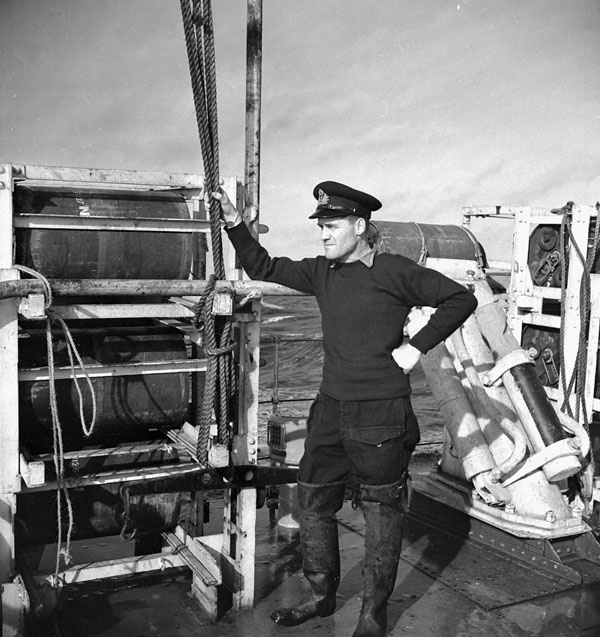
(Lieutenant-Commander Alan H. Easton, aboard frigate HMCS Matane, January 1944)
Staff preoccupation with a myriad of apparently non-essential matters in late 1940 stemmed from the lack of any sense of urgency over the commissioning of the corvette fleet, at least for operational purposes. Despite Nelles stated concern over a possible repeat of 1917, even the Admiralty advised in February 1941 that the RCN could accept a delay in the attainment of competence by its own corvettes. Further, although the navy ardently desired to play a full role overseas in what was described as the "theatre of active operations", the Naval Staff decided in October 1940 that the products of the first construction program would go to meet home requirement first. Once fifty-percent of the latter were met, escorts would be sent to the Eastern Atlantic - the war zone - on an equal priority basis.
Despite the policy of sending auxiliaries overseas and the sure knowledge that the RN was already using its own corvettes as ocean escorts, there is no indication that the RCN believed either that its corvettes would be called up for similar activities or that they required modification to make them more suited to an ocean escort role. The RCN intended that they be primarily used for inshore duty. That duty was reinforced by defense arrangements made by the US and Canada after the fall of Western Europe. August 1940 had seen the new Canadian-American Permanent Joint Board of Defence produce its first basic defence plan (Number 1) for North America. It adopted a worst-case scenario , the complete defeat of Britain by Germany, and then a continuous state of war between Germany and the Commonwealth. It took its sobriquet from its bleak outlook, “Plan Black.” Corvettes under Plan Black were to be formed into five-ship ASW strike forces that would hunt down and destroy U-boats for the RCNs system of defended ports. Primarily hunting in the approaches to harbours or at the focal points of trade. It was expected that in some cases, notably off Halifax and Sydney, corvettes would conduct some local escort, though for Canadian purposes this was not their primary role.
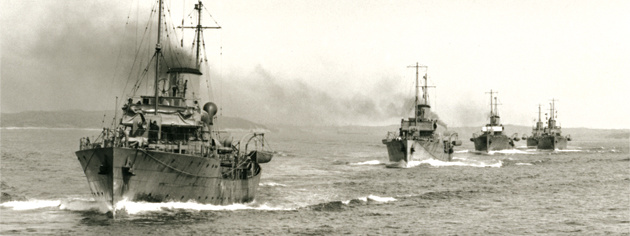
(A line of Corvettes departing Halifax, April 1941.)
In addition to his offensive use of corvettes, the navy also looked forward to the commissioning of the first construction-program ships in order to proceed with many aspects of expansion, such as training. For the professional navy at least the corvette fleet was not the embodiment of naval expansion, Rather it was, as Nelles had said, ‘a stepping stone.’ Events at sea would soon change this, but it would take some time before attitudes in Ottawa would adapt to it.
On the ocean, as the war at sea intensified it pushed further westward. Over the winter the dispersal points under British ASW escort had moved steadily into the mid-Atlantic. The bases in established in Iceland in April 1941 allowed escort to roughly 35 degrees west. This move, in conjunction with a similar extension of air escort, proved initially successful. During April three convoys were attacked in areas that had previously been bereft of escort, and three U-boats were sunk in the ensuing actions. The Germans, once again finding the climate around defended trade too unhealthy, simply pushed further west. In may they struck at HX-126 as it approached the limits of ASW cover. Before the escort could form up, a U-boat pack of six boats attacked and sank five ships. In the face of a continued threat, said convoy was dispersed, which led to further losses. To forestall further German success, the gap in continuous ASW capable escort of convoys between the limits of local Canadian escorts and those of the RN based in Iceland needed to be filled.